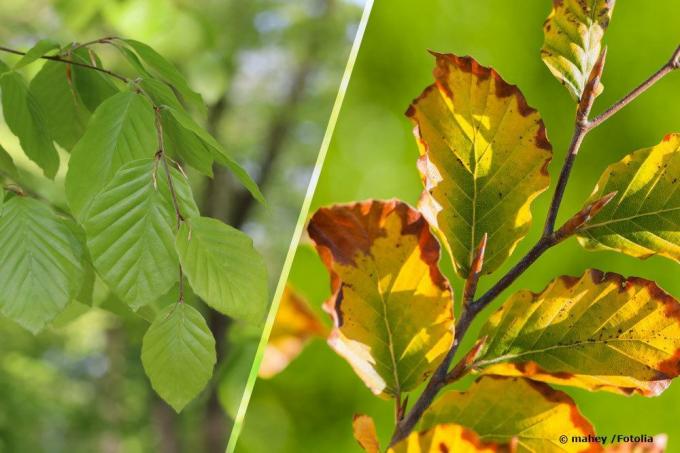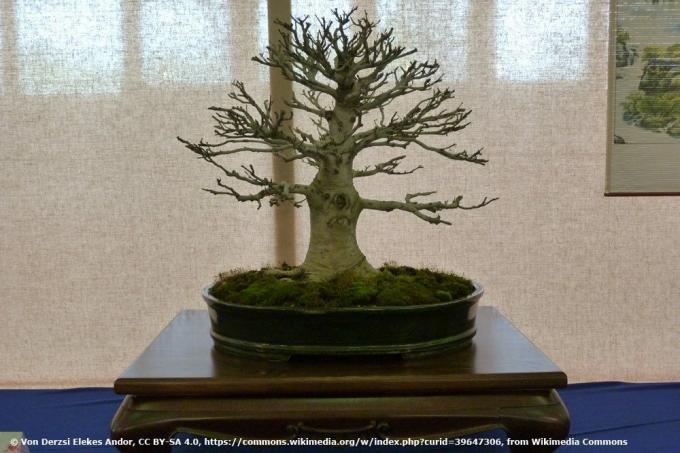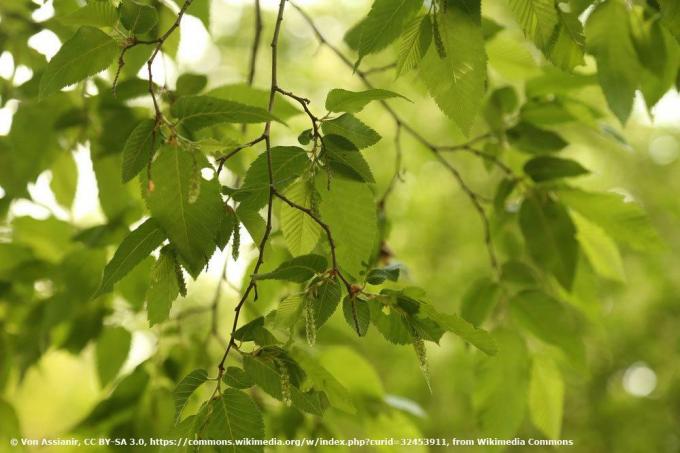
table of contents
- Determine booking
- Book from A - E
- Book from G - K
- Book from O - T
- Similar named genera
- Hornbeam
- Hop beech
- False beech
Beeches (Fagus) from the beech family have a wide distribution area. Of the approximately eleven species, however, only two are native to Europe, the common beech (Fagus sylvatica) and the oriental beech (Fagus orientalis). In German forests they are the most common deciduous trees. In contrast to European beech and copper beech, hornbeam, beech and hop beech are not beeches, even if their name suggests otherwise. They belong to the birch or birch family. Beech family.
Determine booking
- Beeches are one of the so-called periderm trees
- Trees that do not form a bark or only form a bark when they are old
- Deciduous trees with heights of up to 40 m
- The bark is silver-gray and smooth
- Leaves are oblong-ovate, pointed to acuminate
- The leaf color is green, with the exception of the copper beech
- Copper beech, a mutation of the European beech with reddish leaves
- Beeches have female and male flowers (monoecious)
- Flowers and fruits after 10-15 years at the earliest
- Flowers rather inconspicuous
In this country they are valued primarily because of the particular hardness of the wood, which is why they are among the most important Timber belong. They owe their popularity to their triangular, chestnut brown nut fruits, the so-called beechnuts. They contain up to 50% oil, which is why they are used for oil production. However, the main use is in the use of the wood. Even if all beech species are very similar in their appearance, there are still some unmistakable characteristics that can be used to identify each individual beech species.
Book from A - E
American beech (Fagus grandifolia)
- Grows as a medium-sized tree
- Heights of up to 30 m
- Forms a spreading to round and dense crown
- Leaves are 5-12 cm long, up to 7 cm wide
- The upper surface of the leaf is glossy blue-green, but the underside is lighter
- Toothed leaf margins
- Petiole only 3-8 mm long
- The leaves turn orange-yellow to brownish in autumn
- Natural range in eastern and northern Central America
- In North America, however, it is the only naturally occurring species of beech

Chinese beech (Fagus sinensis)
- Reaches heights of up to 25 m
- Growth is rather slender, with a nicely built crown
- Native to northern Vietnam as well as southern and central China
- Leaves are 9-15 cm long
- Leaf margins are serrated and bulged
- Leaf stalks are 1.0-3.5 cm long
- Leaf tops are fresh green, smooth and shiny
- Blue-green undersides, fine and densely hairy
- Autumn color then orange-yellow
Englers beech (Fagus engleriana)
- Native to the south and east of China
- Grows to a height of 15 to 25 m
- Stalked leaves are bluish-green and 4-9 cm long
- The leaves turn orange-yellow in autumn
- Leaf undersides except for the silky hairy veins, glabrous
- Flowering time is from April to May
- Small catkins tend to be inconspicuous

Book from G - K
Shiny beech (Fagus lucida)
- Native to several provinces in east and south China
- Reaches heights between 20 and 25 m
- Glossy green leaves are 5-10 cm long
- Leaf margins slightly serrated
- Leaves smooth and hairless with the exception of the silky hairy main nerve
- Leaf stalks are up to 2 cm long
- Young leaves enjoyed in moderation, edible
- Have a rather mild aroma
tip: Flour is ground from the dried beechnuts to make bread. Roasted they are also used as a coffee substitute and fresh for oil production.
Japanese beech (Fagus japonica)
- Also known as Japanese blue beech
- Natural range is in Japan
- Grows mainly as a multi-stemmed tree with heights of up to 25 m
- Young shoots mostly glabrous
- The name 'blue beech' refers to the bluish color of the leaves
- Leaves 5-9 cm long and 2.5-4.5 cm wide
- Leaf margins slightly notched to entire
- Upper sides of the leaves are bluish-green
- Undersides are yellowish green
- Leaf stalk is about 1 cm long
- It is mainly cultivated as an ornamental wood

Notched beech (Fagus crenata)
- Notched beech is also native to Japan
- Reaches a stately size of up to 35 m there
- Rarely to be found in Central Europe
- Forms a dense treetop with dark green leaves
- Leaves have a wavy, notched edge
- Autumn color of the leaves is golden brown
- In their natural home they are mainly designed as bonsai
- Bonsai design is very important there

tip: The seeds of the notched beech are roasted and then used as a substitute for coffee or to produce oil.
Book from O - T
Oriental beech (Fagus orientalis)
- Natural home is Asia Minor, the Eastern Balkans, the Caucasus and Northern Iran
- Grows up to 40 m
- Dense, conical crown with rising branches
- Very fast growing in the first few years
- Sprouts 2-3 weeks earlier than Fagus sylvatica
- Leaves are 6-12 cm long
- The petiole is 0.5-1.5 cm long and has silky hairs
- Leaf tops are glabrous, dark blue-green and light yellow-green veined
- Leaf margins are finely hairy, entire, wavy or wavy-indented
- Noticeably large buds
- Above all, the wood is used

Common beech (Fagus sylvatica)
- The only beech species native to Germany
- Can reach heights of 20-30 m
- Grows to an old age of around 250 years
- The name does not refer to the color of the leaves
- The decisive factor, however, was the slightly reddish shimmering color of the wood
- Leaves are up to 10 cm long and 5 cm wide
- Leaf margins are wavy
- Leaves glossy dark green from May to July
- Turn brown from August to October
- Petiole is 1.0-1.5 cm long
- Flowers appear at the same time as the leaves
- Copper beech, hornbeam and fern-leaved red beech are ornamental species of Fagus sylvatica

Taiwanese beech (Fagus hayatae)
- The natural home of the Taiwanese beech is China
- In particular, the provinces of Sichuan and Zhejiang are indigenous
- Grows there in summit regions of deciduous forests and on mountain slopes
- Can reach heights of up to 20 m
- Bluish coloration of the leaves and wood, however, is rare
- However, it is mainly cultivated as an ornamental wood
- Leaves are 3-7 cm long, edges serrated and bulged
- Young leaves with silky hairs on the top and bottom
Similar named genera
Hornbeam, hop beech and pseudo-beech are not beeches. Hornbeam and hop beech are among the Birch plants and the dummy books to the genus of Beech family. But here, too, there are features that clearly distinguish these trees from real beeches.
Hornbeam
(Carpinus)
- Hornbeams are confusingly similar to real beeches
- However, the main differences are in the nature of the leaves and the size of the trees
- Achieve heights of growth of a maximum of 25 m
- The trunks are often crooked, brownish and noticeably cracked
- Dense branched crown is initially conical
- Hornbeams grow more rounded and expansive with age
- Leaves much coarser, strongly corrugated and double serrated
- Leaf undersides of young leaves are silky hairy, but later glabrous

Hop beech
(Ostrya)
- Hop beeches reach heights of up to 15 m
- Usually as a single to multi-stemmed large shrub or a broad-crowned, 20 m high tree
- Bark is a dark scale bark
- Leaves are 5-12 cm long, elliptical to oval, double serrated
- The name is derived from the hop-like fruits

False beech
(Nothofagus)
- False beeches are usually evergreen
- Some species are deciduous, two species are semi-evergreen
- Often grow on one side or at a slight angle
- Often multi-stemmed with herringbone branches
- Crown somewhat bizarre, twisted or conical
- Leaves usually very wavy
- Gives off a fresh, spicy scent when budding in spring
- In the garden, heights of up to 12 m are possible


